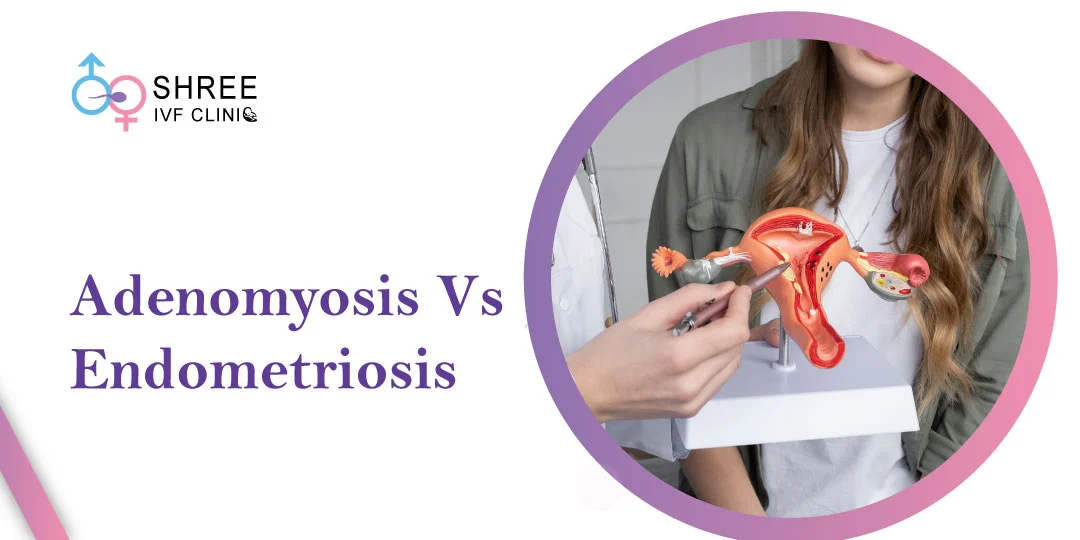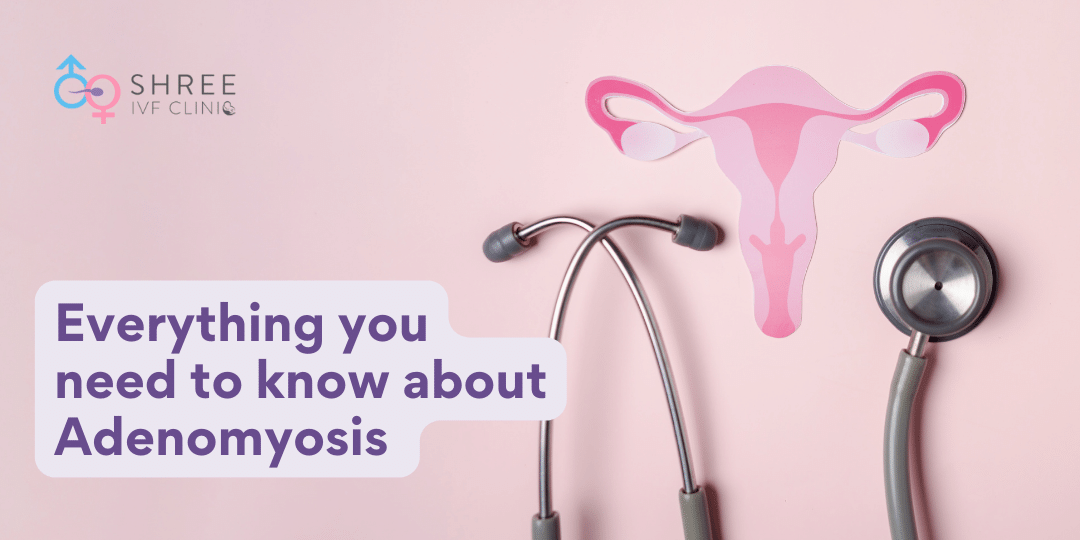What Is the Best Treatment for Adenomyosis?
UPDATED ON 05TH MAY. 2025
Adenomyosis is difficult to diagnose since certain other uterine disorders have signs and symptoms similar to adenomyosis. Fibroid tumors (leiomyomas), uterine cells that develop outside the uterus (endometriosis), and uterine lining (endometrial polyps) growths are all examples of these disorders.
Only after checking out other potential explanations for your signs and symptoms can your doctor determine that you have adenomyosis.
Your doctor may take a sample of uterine tissue for testing (endometrial biopsy) to ensure you don’t have a more severe problem. An endometrial biopsy, on the other hand, will not assist your doctor in confirming adenomyosis.
Adenomyosis is usually detected using imaging techniques such as ultrasound and MRI; there are several marker points that easily allow us to detect adenomyosis on routine ultrasound.
Typically, when we try to look at adenoma in an ultrasound, we are primarily looking at the wall thickness of the uterus.
Now, the wall thickness of the anterior wall is compared to the wall thickness of the posterior wall, and the posterior wall thickness is present more than two times compared to the anterior wall.
This may or may not be associated with endometriosis, and it is typically demarcated in the form of having chocolate cysts and adhesions in the ovaries.

AUTHOR
Dr Jay Mehta
Scientific Director & IVF Specialist with 10+ years of experience
TREATMENT
CONDITION
GET IN TOUCH ON
What is Adenomyosis?
The female reproductive system may be affected by a disorder known as adenomyosis. This results in the uterus being larger; this is due to additional development of the uterine muscular wall. Now, this is predominantly an oestrogen-dependent disease, and this occurs due to an abnormal growth of the uterine endometrium, which normally grows in the cavity. Instead of growing in the cavity, it goes inside the uterine muscle.
The inner surface of the uterine wall (endometrium) is covered with endometrial tissue. When this tissue spreads into the myometrium, often known as the outer muscular walls of the uterus, adenomyosis may develop.
In addition, this additional tissue may cause the uterus to grow to twice or even three times its usual size, resulting in painful periods and irregular uterine bleeding.
The Impact of Adenomyosis on Women’s Fertility
Endometrial tissue (called the endometrium) lines a woman’s uterus. When she develops adenomyosis, her endometrium grows in the incorrect location — into the muscular layer of the uterine wall (called the myometrium).
As a result, heavy menstrual flow (often with blood clots called menorrhagia), pelvic discomfort, painful menstruation and severe menstrual cramps (called dysmenorrhea), painful intercourse, and vaginal bleeding between menstrual cycles are all symptoms of unusual growth.
In addition, an abnormal growth termed an adenomyoma may form in the uterus due to the disorder. Despite this, some women have minor symptoms such as discomfort or bloating in the pelvic area, while up to 35% of those afflicted seem to have no symptoms.
Women who have had at least one child are more likely to develop adenomyosis. However, the disease may make it challenging to conceive or have another child for the first time. Infertility treatments may be beneficial. When you’re pregnant, you’re more likely to develop:
- Miscarriage (pregnancy loss that occurs before the baby has completely developed).
- Premature labor (the baby is born before the 37th week of pregnancy).
Can Adenomyosis Be Cured?
A hysterectomy, in which the uterus is entirely removed, is the only treatment that can be considered an effective cure for adenomyosis. However, this is an option that is only reserved for women who have completed their families.
Also, this is reserved for women who are usually more than the age of 40, considering a hysterectomy for a woman who is less than age 40 may not be an appropriate option for her hormonal, emotional, as well as her mental health.
What is the best treatment for Adenomyosis?
Because adenomyosis symptoms often disappear around menopause, the therapy you get may be determined by how near you are to reaching that stage of life.
However, waiting for menopause is only reserved for women who have a uterus that is less than 8 cm in size and are experiencing extremely minimal symptoms of the disease.
The following are some of the potential treatments for Adenomyosis, which can be classified as medical management and only offer a temporary or symptomatic benefit for the disease
Anti-inflammatory medicines:
To manage the pain, your physician may suggest using anti-inflammatory drugs like ibuprofen. You may lessen the amount of menstrual blood flow and assist in alleviating discomfort by taking an anti-inflammatory drug one to two days before the start of your period and continuing to take it while you are having your period.
Hormonal Therapy:
Hormone therapy is one of the most common treatments for adenomyosis. Hormone therapy works by suppressing estrogen levels, which helps reduce endometrial growth and slow down cell proliferation, resulting in less uterine pain and fewer symptoms overall.
Common hormone therapies include birth control pills or patches, progestin-only medications such as Depo-Provera injections, or gonadotropin-releasing hormone (GnRH) agonists like Lupron Depot or Synarel.
As a patient, you have to remember that medical management is a temporary management, and it is only going to offer a temporary benefit of symptoms. There are some forms of medical management that may give rise to a slight volume reduction of the adenoma, but this is not a permanent volume reduction under any circumstances.
In a country like India, where extremely limited expertise is available for this disease, the majority of the practitioners who do not end up operating on their own are going to place you on some form of temporary medical management, which is going to appease you initially but is going to give rise to tremendous and disastrous consequences in the long term as far as fertility and pain management are concerned.
Surgery:
In severe cases of adenomyosis where hormonal therapies have not been successful in managing symptoms, surgery may be recommended as an effective treatment option.
Surgery can be used to remove any endometrial tissue that has broken through the muscular wall of the uterus and caused inflammation or pain.
The two most common types of surgery are laparoscopic ablation (which removes just the lining of the uterus) and hysterectomy (which removes all uterine tissue).
Depending on your age and health history, your doctor will work with you to determine which type of surgery is best for you.
As far as laparoscopic surgery is concerned, where we are talking of conservative management of the adenoma, we have to understand that these are patients who are predominantly under age 40 and are simultaneously also looking out for fertility management.
A lot of these girls who fall into this bracket and have an adenoma would end up opting for a laparoscopic surgery, ultimately, even after having countless cycles of temporary medical management, which will be offered to them as a promise to cure the adenoma.
If you are a fertility patient. You must distinctly remember that the majority of the fertility practitioners, especially in a country like India, would not be practicing or having any form of expertise as far as management of adenoma is concerned, and as a result of this, they do not have adequate surgical facilities to operate.
They will only offer you temporary medical management, either in the form of tab dinogest or by giving you the favorite GnRH agonist, which they like to provide to the patient.
As a result of this, if you are a patient who is having fertility issues and having an adenoma high time that you end up consulting a specialist for this disease because innovative and new techniques like laparoscopic guided, microwave ablation for focal as well as diffuse adenoma, which has extended till the lateral wall of the uterus can provide the patient with a massive benefit of volume reduction And this massive benefit would end up resulting in an extremely good pregnancy benefit for the patient.
Alternative Therapies
For women who do not want to undergo surgery or take medication, there are also several alternative therapies available to help manage adenomyosis symptoms naturally.
These therapies include acupuncture, herbal remedies such as black cohosh or chasteberry extract, massage therapy, dietary changes such as reducing sugar intake and increasing fiber intake, and stress management techniques like yoga or meditation.
Talk to your doctor about which alternative therapies might be right for you.
How can UAE (Uterine Artery Embolization) help Adenomyosis?
Uterine Artery Embolization (UAE) is the most successful, uterus-sparing, and least invasive treatment option for adenomyosis. It is an outpatient operation that only takes one day to complete. It is carried out by an interventional radiologist (IR) with extensive training and expertise in blood vessel imaging.
To do the surgery, a very small cut must be made either in the wrist or the groin. Next, a tiny catheter is inserted into the blood vessels that feed blood to the fibroid via the incision, which is done with imaging technology.
After that, a tiny number of particles, known as microspheres, are introduced into the artery. These microspheres clog the targeted arteries, cutting off the blood supply to the fibroid.
After that, the fibroids will get smaller in size. As a result, there has been a significant reduction in the size of the fibroids, as well as improvements in the severity of symptoms such as bleeding, pressure, and discomfort.
After the adenomyosis has been successfully embolized, the guide wire and catheter are withdrawn, and a Band-Aid is applied to the point of entry at the top of the patient’s right leg. There is no need for sutures; all that is necessary is a little Band-Aid.
After staying in the recovery room for up to four hours, the patient is sent home to continue their rehabilitation. Normal recovery time at home ranges from three to seven days, and most patients can return to work well before the seventh-day mark.
However, the procedure of embolization is only reserved for those women who are unfit for any form of surgery. This should be offered only as a last line of defense management because it does not provide any other form of curative aspect to the disease.

5,350+
Google Reviews
410K+
subscribers
What happens if you don’t treat adenomyosis?
If left untreated, adenomyosis can lead to painful periods, heavy bleeding during menstruation, and even infertility.
Additionally, the inflammation caused by adenomyosis can cause other reproductive problems such as endometriosis or ovarian cysts. Therefore, it is important to seek treatment for your adenomyosis to prevent any long-term complications.
If you’re facing symptoms like heavy bleeding, severe cramps, pelvic pain, or an enlarged uterus, consult our expert gynecology team and Dr. Jay Mehta, a leading adenomyosis specialist in Mumbai, India. We provide accurate diagnosis and personalized treatment for adenomyosis.
Can adenomyosis shrink naturally?
In some cases, adenomyosis can shrink naturally over time without any intervention. This is mostly seen in women who are approaching menopause and have lowered estrogen levels, which helps to slow down the growth of endometrial tissue.
For younger women, however, hormonal therapy or surgery will likely be necessary to shrink the endometrial tissue and reduce symptoms. Again, it is important to speak with your doctor about the best treatment options available for you.
Shree IVF Clinic’s unique approach to treating Adenomyosis
Shree IVF Clinic is a high-end Mumbai facility specializing in advanced assisted reproduction and advanced pelvic surgery.
The clinic is one of Mumbai’s busiest IVF clinics and is frequently regarded as one of the city’s top fertility clinics by patients and other gynecologists.
The clinic is committed to providing its patients with the best possible quality of medical treatment and advancements in the field of medicine. To provide comprehensive medical treatment under one roof, we have access to all modern facilities and the most cutting-edge medical technology.
Shree IVF Clinic’s team of gynecologists in Mumbai is experienced in treating various endometriosis cases.
We typically try to divide the surgical aspect of the disease into two parts
- If the patient has completed her family and has no further interest in fertility and preferably is older than 30 years and has a uterus size that is more than 10 cm, we typically would offer the patient to undergo complete surgical removal of the uterus, which is also called a hysterectomy.
One has to completely understand that this is also associated many times with endometriosis, and as a result of this, radical excision of the endometriosis is also a very, very important part of the surgical management of this disease.
- However, the vast majority of the patients suffering from this disease of adenomyosis also have a fertility aspect, and the majority of them are very young. In this situation, we would like to divide the disease into two particular aspects.
One is focal adenoma, and the second is diffuse adenoma. It is also important to understand the exact location of the adenoma in the uterus the majority of the time. They are located in the posterior wall of the uterus.
As a result of this, they give rise to severe amounts of pain during menses, which is called dysmenorrhea, and are also greatly associated with infertility. The majority of the patients will ultimately require surgical management, and the surgical management is then divided into either performing techniques with the help of microwave ablation or by performing adenoma removal.
Asked to understand that microwave ablation is an extremely good method in order to achieve pain relief for these patients, these patients also experience a huge amount of fertility benefit after approximately six months of the surgery, because there is a vast reduction in the size of the adenoma.
But at the end of the day, one has to understand that these techniques are to be curated on a personal basis based on the disease process of each patient.
Unfortunately, in a country like India, the majority of the patients who suffer with this disease are grossly misguided because they do not end up visiting a specialist for this disease, as a result of which many of them end up on temporary medical management in the form of either dinogest or are given injectables in the form of GNRH analogues.
The rigid mindset of the patient and extremely poor counseling by the necessary medical professional end up delaying the obvious medical treatment for this patient. As a result of this, the majority of these patients suffer for a prolonged period, having excessive pain during menses.
It’s typically only after years of pain that these patients in India realize that they need to go to a specialist, and once they come to a specialist, they get treated appropriately for this disease and then ultimately experience either pain relief or fertility benefits.
AUTHOR
Dr Jay Mehta
Scientific Director & IVF Specialist with 10+ years of experience
CONDITION
CALL US 24/7 FOR ANY HELP
GET IN TOUCH ON
Share Article on
Recommended Reading
Is Adenomyosis of Uterus Benign or Malignant?
Adenomyosis is a benign condition that causes pain and heavy periods, but it’s not cancerous and won’t turn into cancer
Difference Between Adenomyosis and Endometriosis
Endometriosis causes tissue to grow outside the uterus, while adenomyosis leads to growth within the uterine muscle
What Causes Adenomyosis? Guide to Causes, Diagnosis & Treatments Available
Demystifing Adenomyosis, providing an in-depth overview of its causes, diagnosis, and treatment options through this article. learn more.






